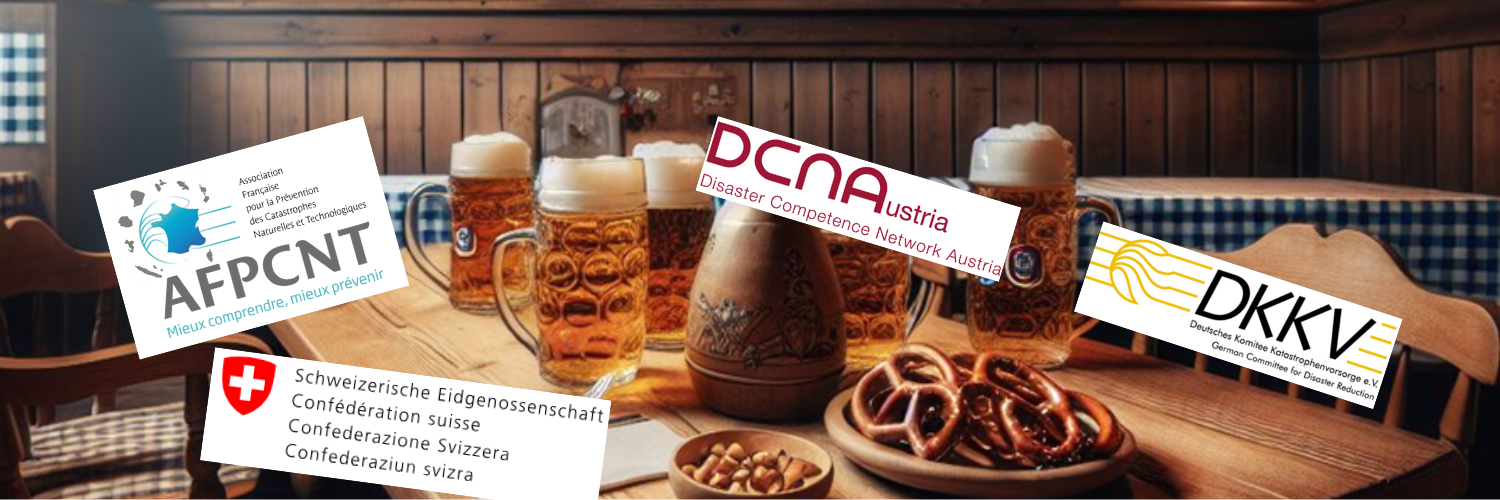Network of Networks
AFPCNT, DCNA, DKKV and PLANAT meet regularly for a “Stammtisch” or “regulars’ table” and thus promote the exchange between different networks at grassroots level.
Natural hazards know no geographical or political boundaries and can affect several regions at the same time, which makes cross-border exchange essential. The exchange of knowledge and experience makes it possible to learn from each other and develop better strategies together. Through close cooperation, challenges can be effectively overcome together and resilience to natural hazards can be strengthened in the long term. For this reason, AFPCNT, DCNA, PLANAT and DKKV have launched a “Network of Networks”.
What is a Network of Networks?
A network of networks is a superordinate network that connects several independent networks in order to exchange knowledge, resources and expertise. This networking creates synergies that enable more effective cooperation and faster solution finding in complex areas such as disaster management, research or technology.
Initially, this grassroots exchange was initiated by the two organizations DKKV (Deutsches Komitee Katastrophenvorsorge) and AFPCNT (Association Française pour la Prévention des Catastrophes Naturelles et Technologiques) over 10 years ago. Over time, the network has grown, and with the DCNA (Disaster Competence Network Austria) and PLANAT (Platform Natural Hazards Switzerland), other important players have been added. This expanded exchange between platforms for civil society, science and national platforms enabled even broader perspectives and improved cooperation at an international level. In order to promote informal and regular communication, a regulars’ table was established to provide participants with a relaxed platform for updates from the individual countries, personal exchange, sharing of ideas, experiences and knowledge. This informal setting enables participants not only to share their professional insights, but also to learn from each other and gain new perspectives.
AFPCNT
The Association Française pour la Prévention des Catastrophes Naturelles et Technologiques (AFPCNT) has been involved in disaster risk management since 2011. It brings together a wide range of stakeholders at national and international level to create a comprehensive, multidisciplinary platform for prevention and resilience. It has been supported by the French Ministry for Ecological Transition since 2022.
DCNA
The Disaster Competence Network Austria (DCNA) is an open, non-profit organization under university management that networks stakeholders in disaster management on an interdisciplinary basis. It promotes research, education and knowledge transfer through the DCNA Academy, conferences and publications.
PLANAT
The Nationale Plattform Naturgefahren (PLANAT) is an extra-parliamentary commission that has been developing integral risk management for natural hazards in Switzerland since 1997. It is committed to a risk-aware society, strategic prevention and the exchange between experts. It is supported by an office at the Federal Office for the Environment (BAFU).
Stammtisch

A “Stammtisch” is a regular, informal meeting of a group of people, often in a pub or café, to exchange ideas in a convivial atmosphere. Originally developed from the tradition of fixed tables for regulars, today it is used for personal and professional exchange on various topics. “Stammtische” offer an ideal platform for discussions, exchanging ideas and socializing and are also increasingly being used for networking meetings. A “Stammtisch” is particularly successful if it takes place regularly, is not too large and participants can exchange ideas in a relaxed atmosphere.
In addition to the “Stammtisch”, the organizations also organize joint events for the general public at which, for example, common challenges or lessons to learn are discussed.
Current Information
No Results Found
The page you requested could not be found. Try refining your search, or use the navigation above to locate the post.


